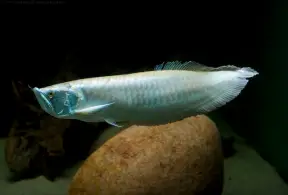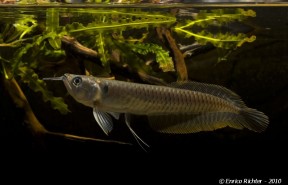Osteoglossum bicirrhosum
Silver Arowana
SynonymsTop ↑
Ischnosoma bicirrhosum Cuvier, 1829; Osteoglossum vandellii Cuvier, 1829; Osteoglossum bicirrhosum Spix & Agassiz, 1829; Osteoglossum arowana Jardine, 1841; Osteoglossum minus Valenciennes, 1847
Etymology
Osteoglossum: from the Greek osteon, meaning ‘bone’, and glossa, meaning ‘tongue’.
bicirrhosum: from the Latin bi, meaning ‘two’, and cirrhosum, meaning ‘tendrilled’, in reference to this species’ barbels.
Classification
Order: Osteoglossiformes Family: Osteoglossidae
Distribution
Cuvier gave type locality as ‘Brazil’, with modern records indicating it to range throughout much of the Amazon basin in Brazil, Peru, Colombia and Ecuador, plus the Rupununi and Oyapock systems in Guyana and French Guiana, respectively.
In the rio Negro, Brazil, plus a handful of blackwater rivers draining into the Río Orinoco through eastern Colombia it’s replaced by the congener O. ferreirai while there exist no records of the genus from the Orinoco or other drainages in Venezuela.
Habitat
Tends to inhabit slow-moving to still tributaries, backwaters and lagoons during the dry season, and moves into areas of flooded forest during periods of inundation.
It’s chiefly a surface dweller preying on smaller fishes and terrestrial insects, and is famed for its ability to leap high out of the water to catch the latter.
Maximum Standard Length
700 – 800 mm.
Aquarium SizeTop ↑
Suitable only for public installations or the very largest private aquaria.
Maintenance
Relatively unfussy although some surface cover in the form of floating or overhanging vegetation or branches is appreciated.
It does best if there is a high proportion of dissolved oxygen and moderate degree of water movement so external filters, powerheads, airstones, etc., should be employed as necessary.
As stable water conditions are obligatory for its well-being this fish should never be added to biologically-immature aquaria and weekly water changes of 30-50% aquarium volume should be considered mandatory.
A tightly-fitting, heavy cover is also essential as Osteoglossum spp. are prodigious jumpers.
Water Conditions
Temperature: 20 – 30 °C
pH: 5.0 – 7.5
Hardness: 36 – 268 ppm
Diet
This species is a generalised predator with intestinal analyses of wild specimens revealing the natural diet to consist of other fishes, terrestrial insects, aquatic invertebrates and plant material in the form of fallen nuts and fruits.
Smaller specimens can be offered bloodworm, small earthworms, chopped prawn and suchlike while adults will accept strips of fish flesh, whole prawns/shrimp, mussels, live river shrimp, larger earthworms, etc.
Insects such as crickets or are also suitable to use although it’s best to fill the stomachs of these by feeding them fish flakes or some kind of vegetable matter before offering them to the fish, while floating dried products can also be used in limited quantities.
Like the vast majority of predatory fishes this species should not be fed mammalian or avian meat such as beef heart or chicken.
Some of the lipids contained in these cannot be properly metabolised by the fish and can cause excess fat deposits and even organ degeneration.
Similarly there is no benefit in the use of ‘feeder’ fish such as livebearers or small goldfish which carry with them the risk of parasite or disease introduction and at any rate tend not have a high nutritional value unless properly conditioned beforehand.
Behaviour and CompatibilityTop ↑
Peaceful with anything too large to swallow and can be maintained in a community provided tankmates are chosen with care.
Aggressively territorial or very competitive species should be avoided with the best choices being similarly-sized fishes such as Cichla spp. and larger doradid or loricariid catfishes.
Other surface-dwellers are best avoided in anything but the very largest installations.
This species can be aggressive towards conspecifics if space is limited and even in larger set-ups a group will form a distinct pecking order.
Reproduction
Unrecorded in aquaria but this species is often bred commercially in outdoor facilities.
It’s a paternal mouthbrooder with the male holding the eggs, and later fry, for a total of around two months.
The fry are normally quite large, measuring around 50-75 mm upon hatching.
They initially have a large external yolk sac and are often available in the ornamental trade at this young age.
Typical brood size is 12-30 and females are capable of producing 50-250 eggs per reproductive season.
NotesTop ↑
Given its eventual size and natural behaviour this species is largely unsuitable for the home aquarium, and we know of only a handful of private aquarists with the facilities required to house it long-term.
Unfortunately juveniles are readily available in the trade, although the scarcity of privately-maintained adults would suggest that most fail to reach their potential.
It’s also an important food fish across much of its native range and is often farmed as such.
O. bicirrhosum can be told apart from its only congener O. ferreirai by the following combination of characters: 42-50 dorsal-fin rays (vs. 52-58 in O. ferreirai); 49-58 anal-fin rays (vs. 61-67); 30-37 lateral-line scales (vs. 37-40); 84-92 vertebrae (vs. 96-100).
Juveniles of the two species are more easily told apart since those of O. bicirrhosum possess only a single dark lateral stripe on the body whereas in O. ferreirai the majority of the body and fins are dark.
The family Osteoglossidae is considered to date back to the Jurassic Period around 150 million years and appears to have changed little in that time.
It’s the only family of freshwater fishes with extant members on both sides of Wallace’s Line, with four valid species in South America, one in Africa, one in Southeast Asia, and two in Australia.
Members are commonly referred to as ‘bony-tongues’ in reference to a toothed plate in the lower jaw and are able to use their swim bladder as an accessory breathing organ.
References
- Kanazawa, R. H., 1966 - Ichthyologica, the Aquarium Journal 37(4): 161-172
The fishes of the genus Osteoglossum with a description of a new species from the Rio Negro. - Lowry, D., A. P. Wintzer, M. P. Matotta, L. B. Whitenacka, D. R. Hubera, M. Dean and P. J. Motta, 2005 - Environmental Biology of Fishes 73: 453-462
Aerial and aquatic feeding in the silver arawana, Osteoglossum bicirrhosum. - Reis, R. E., S. O. Kullander and C. J. Ferraris, Jr. (eds.), 2003 - EDIPUCRS, Porto Alegre: i-xi + 1-729
Check list of the freshwater fishes of South and Central America. CLOFFSCA.





August 24th, 2015 at 11:37 am
Hi all,
I have a 2 males / 1 female group of Osteoglossum in my 2650 US gallons amazonian tank from September 2011… they gently come to maturity and I could see this last Friday (August, 21st) that they are mature indeed : I have a male in incubation with a 1st time !
the spawning was not expected, but stimulated by a one shot high volume water change (80%), a drop of temperature at 23°C and a cleaning of the tank bottom. I hadn’t done this cleaning from the beginning of the set up (back in summer 2011)
my next problem is to experiment how to net the male to make him spit his eggs (or larvae) without him to swallow them by stress…
any suggestion welcome.
June 4th, 2016 at 8:51 pm
Notice that on mature individuals, sexing is very easy. On the pictures on this page, picture one is a male… picture 3 is a female. Identifying is with the lower lip which “covers” the upper on the male (for mouth larvae mouth brooding).